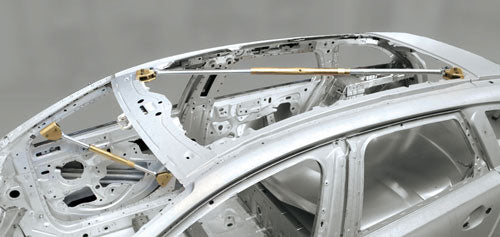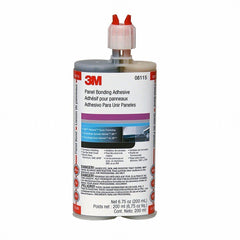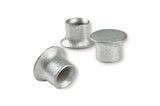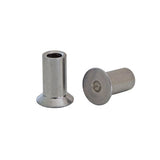Need Some Help? 0161 223 1843
Need Some Help? 0161 223 1843

February 06, 2020 5 min read 4 Comments
Riveting of vehicle panels (especially aluminium) is becoming more of the norm nowadays but it is still mostly applicable to the more expensive vehicles. Over the last 20 years, manufacturers have developed there techniques and equipment have become more sophisticated. The first SPR was invented by Ralph Furhmeister in his garage and was picked up by Jaguar Landrover for use in its aluminium bodied vehicles.
Legislation has helped in pushing vehicles to become lighter and more C02 efficient. The introduction of the EU directive 443/2009 gave a limit to the maximum permissible values for C02. To reinforce this higher taxes would be implemented and also manufacturers fined.
This pushed manufacturers to increase energy efficiency and reduce weight. They experimented with joining aluminium, magnesium, plastics, composites, and AHSS steels together in varying degrees and this could only be performed by bonding and riveting. A typical steel vehicle has up to 6000 spot welds, a riveted shell maybe 3500 rivets. This and the use of lighter materials and fewer joints means shells could be made lighter, stronger and quicker.

Slowly more types of rivet have been invented such as Flow Form, Blind, Breakstem and POP riveting. This has been the preferred way of joining aluminium as spot welding is very difficult in production and cannot be reproduced in aftermarket body repair full stop. You require 5 times the power to spot weld aluminium compared to steel and these sort of outputs are just not available in body repair shops. Another advantage of bond and riveting is that dissimilar materials can be joined together ie steel to aluminium. Aluminium joined directly to steel, would cause galvanic corrosion, therefore, placing a bond joint in between the panels and using a rivet made of Titanium keeps the panels separate would negate this corrosion.
Advantages in steel
More high strength steels are now used in vehicle manufacture and these are particularly heat-sensitive they are also more prone to corrosion affecting the integrity of the joint so preferring rivet and bonding in aftermarket repair reduces these problems and keeps manufactures body corrosion warranties (some up to 12 years). It
Correct repair is therefore critical and the use of manufacturers method of repair instructions or "method Sheets" is important. These method sheets give the technician lots of information on where to section and how to replace the damaged panel so that the integrity of the vehicle is still maintained.
Carrying out panel replacements without consulting the vehicle repair methods may result in:
Bonding on its own is not structural, you will always find bonding with a mechanical property. This could be a spot weld, rivet or bolt etc.
Bond peels or "zips", if you can split from the start of the joint. This zipping effect is reduced if a mechanical is incorporated.
The mechanical fixing (rivet) holds the assembly together during the adhesive curing stage. Bond peels or "zips", if you can split from the start of the joint. This zipping effect is reduced if a mechanical is incorporated.
The result is that bonding and riveting are going to be more prevalent as newer more exotic steels, aluminium and plastics need to be joined together for strength and weight saving. Welding these dissimilar materials together becomes easier with rivet and bond, therefore, we feel it is here to stay


The use of the correct manufacturers approved adhesive is also critical, technicians should be aware of the type, cleaning materials and use-by date when using bonding.
Many structural bonds use mixing tubes so, therefore, ensure you carry out a purge of the bond the same length of the tube to ensure your applied bond is mixed correctly. We would also recommend a bond tag with the date and time on it to ensure that your bond does, in fact, go hard before the vehicle leaves the premises. 3M 08115 BONDING TECHNICAL INSTRUCTIONS DOWNLOAD
Failure to follow the adhesive manufacturer's instructions may result in:
Many different manufacturers have different work and curing times for there bond and this must also be noted. Work time is the period of time after an adhesive has been mixed with its hardener/activator that it will remain workable, for example, a time where a panel may be adjusted or realigned.
Some allow accelerated cure times using heating pads/blankets or infrared lamps and again consult manufacturers recommend times and heat inputs.
Example:

Different rivets are used in different parts of the vehicle, this is critical especially in SPR. The Length of the rivet must be correct for that part of the vehicle otherwise the anvils cannot form the SPR correctly and the joint will not be strong enough. In the video, you can see the SPR is forced into the panels and the rear anvil forces the legs of the rivet to spread. They shouldn't breakthrough and the rivet face must be flush. To stop incorrect rivets being used many manufacturers produce there own rivets and these are supplied with the new panel for repair.
Many Rivets are also specially coated so that they do not corrode or cross-contaminate the panels to be joined. A zinc coating tends to be used on steel, zinc, and tin used on aluminium with a bake temperature up to 160 degrees centigrade.
There is also a special coating called Almac used on temperatures over 180 degrees Centigrade.

Blind rivets or break stem rivets are tubular fasteners with a mandrel through the centre. Blind rivets are inserted into drilled holes in the parts to be joined, and a special tool is used to draw the mandrel through the body of the rivet. The blind end expands, and the mandrel is snapped off. Unlike solid rivets, blind rivets can be installed in joints from only one side of the part—making them “blind” to the opposite side.
It is important that the correct length of rivet is selected according to the stack thickness failure to do this would mean the rivet will not sufficiently protrude through the total 'stack' of materials/panels, therefore the joint will be weak.

SPR or Self Piercing Rivets can be used with no preparation. The action of the rivets piercing the material forces it into the shaping anvil behind forcing the legs of the rivet to splay. This with the correct force applied gives the required strength. SPR rivets can be used to join dissimilar materials together as well as similar. Always ensure the correct depth of the rivet and the correct fitment anvils to ensure to correct strength of the joint. SPR Rivets are installed using tools like the GYSPRESS 8T Riveting Tool or the PRO-RIV or the Avdel ESN 50

Flow form rivets are used when you have an existing hole.or on structural panels where there has been an existing SPR. Placing them in the existing holes eliminates any further damage to the adjoining panel flange. They can be used on steel, aluminium, composites, and plastics. Flow form Rivets require higher squeeze pressures up to 10 Tons.
August 10, 2023
Thank you for providing such a wealth of valuable information. It’s like discovering hidden treasure.
dojo rivet
November 21, 2022
I observed a few misspelling in this article; however, excellent information about the new repair process for today’s vehicles and the use of advance metals ( ALUMINUM ).
July 13, 2022
I observed a few misspelling in this article; however, excellent information about the new repair process for today’s vehicles and the use of advance metals ( ALUMINUM ).
Comments will be approved before showing up.
Ankit Singh
August 10, 2023
This post is a goldmine of information, and your generosity in sharing it makes it even more valuable.
dojorivet